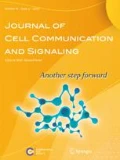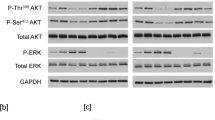Abstract
The binding of antigen to the B cell receptor (BCR) results in a cascade of signalling events that ultimately drive B cell activation. Uncontrolled B cell activation is regulated by negative feedback loops that involve inhibitory co-receptors such as CD22 and CD32B that exert their functions following phosphorylation of immunoreceptor tyrosine-based inhibition motifs (ITIMs). The CD22-targeted antibody epratuzumab has previously been shown to inhibit BCR-driven signalling events, but its effects on ITIM phosphorylation of CD22 and CD32B have not been properly evaluated. The present study therefore employed both immunoprecipitation and flow cytometry approaches to elucidate the effects of epratuzumab on direct phosphorylation of key tyrosine (Tyr) residues on both these proteins, using both transformed B cell lines and primary human B cells. Epratuzumab induced the phosphorylation of Tyr822 on CD22 and enhanced its co-localisation with SHP-1. Additionally, in spite of high basal phosphorylation of other key ITIMs on CD22, in primary human B cells epratuzumab also enhanced phosphorylation of Tyr807, a residue involved in the recruitment of Grb2. Such initiation events could explain the effects of epratuzumab on downstream signalling in B cells. Finally, we were able to demonstrate that epratuzumab stimulated the phosphorylation of Tyr292 on the low affinity inhibitory Fc receptor CD32B which would further attenuate BCR-induced signalling. Together, these data demonstrate that engagement of CD22 with epratuzumab leads to the direct phosphorylation of key upstream inhibitory receptors of BCR signalling and may help to explain how this antibody modulates B cell function.








Similar content being viewed by others
Abbreviations
- BCR:
-
B cell receptor
- HD:
-
Healthy donor
- FcR:
-
Fc receptor
- ITIM:
-
Immunoreceptor tyrosine-based inhibition motif
- PBMC:
-
Peripheral blood mononuclear cells
- SLE:
-
Systemic lupus erythematosus
- Tyr:
-
Tyrosine
References
Ackermann JA, Radtke D, Maurberger A, Winkler TH, Nitschke L (2011) Grb2 regulates B-cell maturation, B-cell memory responses and inhibits B-cell Ca2+ signalling. EMBO J 30:1621–1633
Carnahan J, Wang P, Kendall R, Chen C, Hu S, Boone T, Juan T, Talvenheimo J, Montestruque S, Sun J (2003) Epratuzumab, a humanized monoclonal antibody targeting CD22: characterization of in vitro properties. Clin Cancer Res 9:3982s–3990s
Catalán D, Aravena O, Sabugo F, Wumann P, Soto L, Kalergis AM, Cuchacovich M, Aguillón JC (2010) B cells from rheumatoid arthritis patients show important alterations in the expression of CD86 and FcγRIIb, which are modulated by anti-tumor necrosis factor therapy. Arth Res Ther 12:R68
Coggeshall KM (1998) Inhibitory signals by B cell FcγRIIb. Curr Opin Immunol 10:306–312
Dörner T, Shock A, Smith KG (2012) CD22 and autoimmune disease. Int Revs Immunol 31:363–378
Dörner T, Shock A, Goldenberg DM, Lipsky PE (2015) The mechanistic impact of CD22 engagement with epratuzumab on B cell function: implications for the treatment of systemic lupus erythematosus. Autoimmun Rev 14:1079–1086
Fleischer V, Sieber J, Fleischer SJ, Shock A, Heine G, Daridon C, Doerner T (2015a) Epratuzumab inhibits the production of proinflammatory but not regulatory cytokines by B cells from healthy donors and SLE-patients. Arth Res Ther 17:185
Fleischer SJ, Daridon C, Fleischer V, Lipsky PE, Dörner T (2015b) Enhanced tyrosine phosphatase activity underlies dysregulated B-cell receptor signaling and promotes survival of human lupus B-cells. Arthritis Rheumatol Accept Article. doi:10.1002/art.39559
Goldenberg DM (2006) Epratuzumab in the therapy of oncological and immunological diseases. Expert Rev Anticancer Ther 6:1341–1353
Grimaldi CM, Hicks R, Diamond B (2005) B cell selection and susceptibility to autoimmunity. J Immunol 174:1775–1781
Isnardi I, Lesourne R, Bruhns P, Fridman WH, Cambier JC, Daëron M (2004) Two distinct tyrosine-based motifs enable the inhibitory receptor FcRIIB to cooperatively recruit the inositol phosphatases SHIP1/2 and the adapters Grb2/Grap. J Biol Chem 279:51931–51938
Jacobi AM, Goldenberg DM, Hiepe F, Radbruch A, Burmester GR, Dörner T (2008) Differential effects of epratuzumab on peripheral blood B cells of patients with systemic lupus erythematosus versus normal controls. Ann Rheum Dis 67:450–457
Jang IK, Zhang J, Gu H (2009) Grb2, a simple adapter with complex roles in lymphocyte development, function, and signaling. Immunol Rev 232:150–159
Keren Z, Melamed D (2005) Antigen receptor signaling competence and the determination of B cell fate in B-lymphopoiesis. Histol Histopathol 20:187–196
Mackay M, Stanevsky A, Wang T, Aranow C, Li M, Koenig S, Ravetch JV, Diamond B (2006) Selective dysregulation of the FcγRIIB receptor on memory B cells in SLE. J Exp Med 203:2157–2164
Maloney A, Hotson D, Rapecki S, Fossati G, Lumb S, Rosen D, Putta S, Wale N, Spellmeyer D, Cesano A, Hawtin R, Shock A (2014) Epratuzumab induces broad inhibition of B cell receptor proximal signaling but has opposing effects on distal signaling in B cell subsets: a profile of effects on functional immune signaling by single cell network profiling. Arthritis Rheum 66:S1255
Muta T, Kurosaki T, Misulovin Z, Sanchez M, Nussenzweig MC, Ravetch JV (1994) A 13-amino-acid motif in the cytoplasmic domain of Fc gamma RIIB modulates B-cell receptor signalling. Nature 368:70–73
Neumann K, Oellerich T, Heine I, Urlaub H, Engelke M (2011) Fc gamma receptor IIb modulates the molecular Grb2 interaction network in activated B cells. Cell Signal 23:893–900
Nitschke L (2005) The role of CD22 and other inhibitory co-receptors in B-cell activation. Curr Opin Immunol 17:290–297
Otipoby KL, Draves KE, Clark EA (2001) CD22 regulates B cell receptor-mediated signals via two domains that independently recruit Grb2 and SHP-1. J Biol Chem 276:44315–44322
Poe JC, Fujimoto M, Jansen PJ, Miller AS, Tedder TF (2000) CD22 Forms a quaternary complex with SHIP, Grb2, and Shc: a pathway for regulation of B lymphocyte antigen receptor-induced calcium flux. J Biol Chem 275:17420–17427
Qu Z, Goldenberg DM, Cardillo TM, Shi V, Hansen HJ, Chang C-H (2008) Bispecific anti-CD20/22 antibodies inhibit B-cell lymphoma proliferation by a unique mechanism of action. Blood 111:2211–2219
Ravetch JV, Bolland S (2001) IgG Fc receptors. Ann Rev Immunol 19:275–290
Rossi EA, Goldenberg DM, Michel R, Rossi DL, Wallace DJ, Chang C-H (2013) Trogocytosis of multiple B-cell surface markers by CD22 targeting with epratuzumab. Blood 122:3020–3029
Saxon A, Feldhaus J, Robins RA (1976) Single step separation of human T and B cells using AET treated SRBC rosettes. J Immunol Methods 12:285–288
Shock A, Kilgallen B, Koetse W, Stach C, Bongardt S, Galateanu C (2014) Pharmacodynamic effects of the CD22-targeted monoclonal antibody epratuzumab on B cells in patients with systemic lupus erythematosus. Arthritis Rheum 66:S856
Sieger N, Fleischer S, Mei H, Reiter K, Shock A, Burmester G, Daridon C, Dörner T (2013) CD22 ligation inhibits downstream B cell receptor signaling and Ca2+ flux upon activation. Arthritis Rheum 65:770–779
Tsubata T (2012) Role of inhibitory BCR co-receptors in immunity. Infect Disord Drug Targets 12:181–190
Veri M-C, Burke S, Huang L, Li H, Gorlatov S, Tuaillon N, Rainey GJ, Ciccarone V, Zhang T, Shah K, Jin L, Ning L, Minor T, Moore PA, Koenig S, Hohnson S, Bonvini E (2010) Therapeutic control of B cell activation via recruitment of Fcγ receptor IIb (CD32B) inhibitory function with a novel bispecific antibody scaffold. Arthritis Rheum 62:1933–1943
Acknowledgments
The authors acknowledge Jennifer Timoshanko, PhD, UCB Pharma, UK, for publication coordination and Helen Chambers, DPhil, Costello Medical Consulting, UK, for editorial assistance, which was funded by UCB Pharma. The authors also thank Helen Brand, BSc, UCB Pharma, UK, for preparing epratuzumab F(ab’)2 and Fab batches.
Author contributions
SL designed the study, performed the experiments, analyzed the data, wrote the manuscript and was involved in the interpretation of the data. SJF and AW designed the study, performed the experiments, analyzed the data and were involved in the interpretation of the data. AS designed the study, analyzed the data, wrote the manuscript and was involved in the interpretation of the data. AM, CD and TD designed the study, analyzed the data and were involved in the interpretation of the data. All authors critically reviewed the manuscript for important intellectual content and approved the final version.
Author information
Authors and Affiliations
Corresponding author
Rights and permissions
About this article
Cite this article
Lumb, S., Fleischer, S.J., Wiedemann, A. et al. Engagement of CD22 on B cells with the monoclonal antibody epratuzumab stimulates the phosphorylation of upstream inhibitory signals of the B cell receptor. J. Cell Commun. Signal. 10, 143–151 (2016). https://doi.org/10.1007/s12079-016-0322-1
Received:
Accepted:
Published:
Issue Date:
DOI: https://doi.org/10.1007/s12079-016-0322-1




